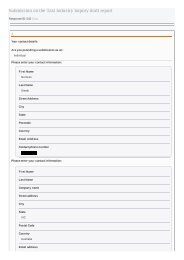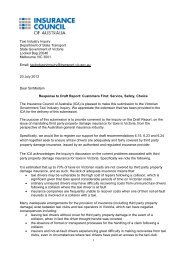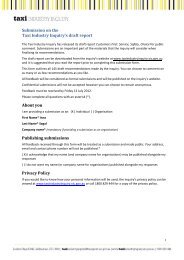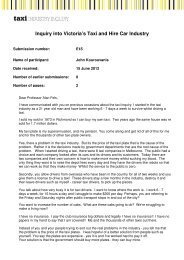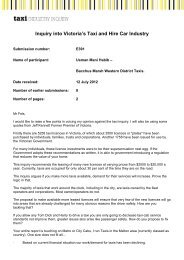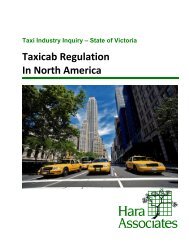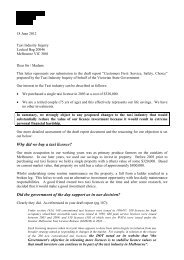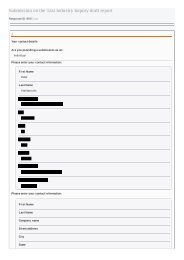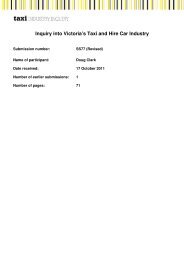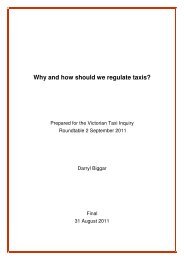Part D â Understanding and improving industry performance (PDF ...
Part D â Understanding and improving industry performance (PDF ...
Part D â Understanding and improving industry performance (PDF ...
You also want an ePaper? Increase the reach of your titles
YUMPU automatically turns print PDFs into web optimized ePapers that Google loves.
11.6. Complaints h<strong>and</strong>ling by NSPs<br />
Under the accreditation scheme for primary NSPs they are<br />
required to “operate a complaints management system<br />
that is consistent with Australian St<strong>and</strong>ard AS 10002,<br />
including procedures for complaint resolution <strong>and</strong> referrals<br />
to other parties”. 48 Despite this requirement, the inquiry has<br />
heard that taxi users generally get very little satisfaction<br />
from complaining about booking services to an NSP.<br />
One customer relates that, after having booked a taxi<br />
well in advance for an elderly friend <strong>and</strong> having the taxi<br />
fail to turn up:<br />
I rang [the NSP] to be informed that they had no<br />
such record of my booking … I subsequently rang<br />
the company’s head office <strong>and</strong> was told that in fact,<br />
there was a tape recording of my original booking<br />
request made the day beforeh<strong>and</strong> with all details<br />
exactly as I had related them. I once again emailed<br />
the company. I received what I consider to be<br />
barely an apology, let alone reassurances regarding<br />
future improvements. 49<br />
Another taxi user related their view to Ipsos during<br />
their research:<br />
It’s a well known fact that the taxi <strong>industry</strong> never does<br />
anything about complaints. 50<br />
This approach by NSPs in h<strong>and</strong>ling complaints is perhaps<br />
further evidence of the weak competition that troubles<br />
the market for network services <strong>and</strong> is a result of them<br />
successfully evading any responsibility to taxi customers<br />
for the delivery of services referring that responsibility to<br />
taxi drivers <strong>and</strong> to a lesser extent taxi operators.<br />
Inquiry findings<br />
è Taxi users are highly dissatisfied with the<br />
reliability of taxi booking services, particularly<br />
during peak periods.<br />
è Customers reasonably expect that the<br />
company they contact for the booking of a<br />
taxi is accountable to them for the delivery<br />
of the taxi service, <strong>and</strong> despite NSPs being<br />
well placed to guarantee the service of their<br />
affiliates they have decided not to do so.<br />
11.7. Concerns about NSPs<br />
In addition to complaints about taxi booking services, a<br />
number of other concerns relating to NSPs have been<br />
raised with the inquiry.<br />
11.7.1. Competition between NSPs <strong>and</strong> the<br />
role of the ACCC<br />
As noted earlier in this chapter, many taxi operators have<br />
expressed the view to the inquiry that concentration in<br />
the number of NSPs in Melbourne is problematic. These<br />
operators argue that this concentration has contributed<br />
to a lack of competitive pressure on NSPs to keep their<br />
costs down or to improve their service offerings.<br />
The market in which NSPs compete has become much<br />
more concentrated over the last 25 years. At the time of<br />
the Foletta inquiry in 1986, there were eight depots; by<br />
the time of the KPMG NCP review in 1999, there were<br />
seven. Currently, the market is highly concentrated,<br />
with only two large firms <strong>and</strong> one smaller competitor.<br />
By one conventional measure of market concentration,<br />
the Hirshman-Herfindahl Index (HHI), concentration has<br />
increased to a level where it would be considered highly<br />
concentrated by competition authorities around the<br />
world. 51 The inquiry’s calculations suggest that, if market<br />
share is measured by the number of operators connected<br />
to the NSP, the HHI for the metropolitan market has<br />
increased from 3,240 to 4,750 over the last 12 years<br />
(where 10,000 is consistent with a monopoly <strong>and</strong> 5,000<br />
with a duopoly).<br />
Some of this increase in concentration can be attributed<br />
to smaller companies growing ‘organically’ at the<br />
expense of their competitors. However, mergers <strong>and</strong><br />
acquisitions have also contributed substantially to the<br />
increased concentration. Mergers <strong>and</strong> acquisitions<br />
of NSPs have been overseen by the Australian<br />
Competition <strong>and</strong> Consumer Commission (ACCC), the<br />
statutory body charged with enforcing the Australian<br />
Competition <strong>and</strong> Consumer Act 2010. Section 50<br />
of the Act provides that mergers or acquisitions<br />
are prohibited if they would have the effect or likely<br />
effect of substantially lessening competition.<br />
48 Transport (Compliance <strong>and</strong> Miscellaneous) Act 1983, section 133C,<br />
Business <strong>and</strong> Service St<strong>and</strong>ards, part 3 (22)<br />
49 Irene Goldwasser, Op. Cit., p.3<br />
50 Ipsos Social Research Institute (2012), Op. Cit., p.86<br />
51 The HHI is calculated by adding the sum of the squares of the postmerger<br />
market share of the merged firm <strong>and</strong> each rival firm in the<br />
relevant market, thereby giving greater weight to the market shares of<br />
the larger firms. (ACCC, Merger Guidelines 2008, p.37)<br />
238




